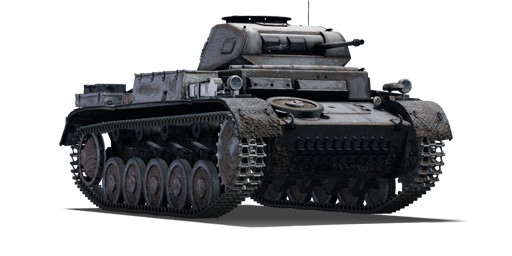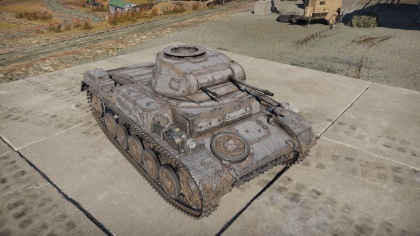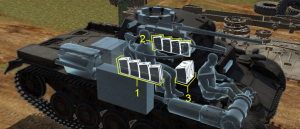Pz.II F
Contents
Description
The Pz.Kpfw. II Ausf. F is a rank German light tank
with a battle rating of (AB), (RB), and (SB). It was introduced during the Closed Beta Test for Ground Forces before Update 1.41.
Performance is similar to other low-rank German tanks, but the gun makes it stand out. With careful use, it is easily one of the best low-rank German tanks, but due to slow turret traverse and long reload between belts, it is just as easy to fail in.
General info
Survivability and armour
The Panzer II F is slightly less protected than the Panzer II C coming before it, with 30mm front plating on its turret & hull instead of the 35mm on its predecessor. It still has three crew, so it is easy to one-shot knock-out with most ammo types.
Armour type:
- Rolled homogeneous armour
| Armour | Front | Sides | Rear | Roof |
|---|---|---|---|---|
| Hull | 30 mm (11°) Front plate 20 mm (73°) Front glacis 35 mm (36°) Bottom glacis |
20 mm | 15 mm | 15 mm |
| Turret | 30 mm | 15 mm | 15 mm | 10 mm |
Notes:
- Suspension wheels are 10 m thick while tracks are 15 mm thick.
- Frontal lower plate is 35 mm thick at 36° angle, and covered by attached tracks, counting as additional 10 mm of armour; enough to deflect most shells it faces.
Mobility
Mobility is identical to the Panzer II C, they use the same engine, transmission, and weigh almost the exact same.
| Mobility characteristic | ||
|---|---|---|
| Weight (tons) | Add-on Armor weight (tons) |
Max speed (km/h) |
| 9.1 | N/A | 49 (AB) |
| 44 (RB/SB) | ||
| Engine power (horsepower) | ||
| Mode | Stock | Upgraded |
| Arcade | 216 | 267 |
| Realistic/Simulator | 123 | 140 |
| Power-to-weight ratio (hp/ton) | ||
| Mode | Stock | Upgraded |
| Arcade | 23.74 | 29.34 |
| Realistic/Simulator | 13.52 | 15.38 |
Armaments
Main armament
The chief difference between the Panzer II F and its predecessor is the main gun. The II F uses the 20 mm KwK 38, which has almost double the fire rate compared to the KwK 30. The magazine size did not change, still limited to ten rounds of ammunition. The reload time is also identical, so while it is tempting to "spray-n-pray", it is more practical to use it like you would an autoloading tank at higher ranks and administer trigger control to make the shots count. With the Panzer II F, you do not have to worry about changing ammunition performance with every shot, which makes the "autoloader-like" playstyle more attractive, unlike similar-BR Italian tanks using 20 mm autocannons, the AB41 and L6/40.
| 20 mm KwK 38 | |||||
|---|---|---|---|---|---|
| Capacity (Belt capacity) | Fire rate (shots/minute) |
Vertical guidance |
Horizontal guidance |
Stabilizer | |
| 180 (10) | 450 | -9°/+20° | ±180° | N/A | |
| Turret rotation speed (°/s) | |||||
| Mode | Stock | Upgraded | Prior + Full crew | Prior + Expert qualif. | Prior + Ace qualif. |
| Arcade | 13.33 | 18.45 | 22.40 | 24.77 | 26.35 |
| Realistic | 8.33 | 9.80 | 11.90 | 13.16 | 14.00 |
| Reloading rate (seconds) | |||||
| Stock | Prior + Full crew | Prior + Expert qualif. | Prior + Ace qualif. | ||
| 7.80 | 6.90 | 6.36 | 6.00 | ||
Ammunition
| Penetration statistics | |||||||
|---|---|---|---|---|---|---|---|
| Ammunition | Type of warhead |
Penetration in mm @ 90° | |||||
| 10m | 100m | 500m | 1000m | 1500m | 2000m | ||
| PzGr | API-T | 35 | 33 | 26 | 18 | 13 | 9 |
| PzGr 40 | HVAP-T | 64 | 63 | 26 | 8 | 3 | 1 |
| Sprgr. | HEFI-T* | 2 | 2 | 2 | 2 | 2 | 2 |
| Shell details | ||||||||||
|---|---|---|---|---|---|---|---|---|---|---|
| Ammunition | Type of warhead |
Velocity in m/s |
Projectile Mass in kg |
Fuse delay
in m: |
Fuse sensitivity
in mm: |
Explosive Mass in g (TNT equivalent): |
Normalization At 30° from horizontal: |
Ricochet: | ||
| 0% | 50% | 100% | ||||||||
| PzGr | API-T | 780 | 0.15 | N/A | N/A | N/A | -1° | 47° | 60° | 65° |
| PzGr 40 | HVAP-T | 1,050 | 0.1 | N/A | N/A | N/A | +1.5° | 66° | 70° | 72° |
| Sprgr. | HEFI-T* | 900 | 0.11 | 0.3 | 0.1 | 10.2 | +0° | 79° | 80° | 81° |
Belt types
| Belts | Shell composition | Combat usage |
| Default | API-T, HEFI-T (Armour Piercing Incendiary tracer – High Explosive Fragmentation Incendiary tracer) shell |
50% of this belt are useless against tanks or planes. However against other SPAA this belt can reliably take out crew, armament, ammo and engine. Having one belt in reserve does not hurt. |
| PzGr | API-T (Armour Piercing Incendiary tracer) shell |
Intermediate usage until the better PzGr 40 can be used. Decent enough versus light tanks and other vehicles from the rear. Due the lack of HE filler underwhelming damage, yet still better than the PzGr 40. |
| PzGr | HVAP-T (High Velocity Armour Piercing tracer) shell |
Best penetrating shell of this vehicle. However, the damage effects are very poor. In close combat snipe for modules and crew member for increased survival rate. Nothing is more annoying than emptying a clip and then to get out-gamed during the reload because the enemy gunner survived. Against angled armoured it is not very effective like any other ACPR shell, this is offset by the very high base penetration though. |
Ammo racks
| Full ammo |
1st rack empty |
2nd rack empty |
Visual discrepancy |
|---|---|---|---|
| 18 | 10 (+8) | 1 (+17) | Yes |
Machine guns
Just like its predecessor, this tank has one coaxial 7.92 mm MG 34. Due to slow turret traverse common to most lower-rank German tanks, this is not a very practical weapon.
| 7.92 mm MG 34 | ||||||
|---|---|---|---|---|---|---|
| Coaxial mount | ||||||
| Capacity (Belt capacity) | Fire rate (shots/minute) |
Vertical guidance |
Horizontal guidance | |||
| 1,800 (150) | 900 | N/A | N/A | |||
Usage in battles
This tank is similar to the Panzer II C, an average light tank for lower ranks with decent armour and decent mobility, but a very potent cannon. It does not work well against sloped armour due to poor normalization of APCR rounds. The higher rate of fire is actually quite punishing since it means that the normal player is continuous firing and reloading more often. If used like an autoloader tank from higher ranks, however, it becomes more accurate and effective. Do not get overconfident in this tank just because your gun shoots fast and has good penetration, unfortunately, APCR post-penetration damage is lacklustre here. Furthermore, the slightly higher battle rating of 1.3 means it can be pitted against the B1 ter which it cannot reliably penetrate from the front or the side even when utilising the APCR belt.
Furthermore, poor turret traverse means that the tank can easily be outmanoeuvred by a Stuart or BT. This relative difference is the same in both AB and RB/SB.
Find a good position, be patient, and double-check before moving in. If you wish to brawl, have others covering your flanks to mitigate slow turret traverse.
Pros and cons
Pros:
- Great penetration for rank with 64 mm pen APCR belt
- Amazing fire rate for rank, identical to the Flak 38 cannon
- Decent and very trolly armour for the rank against the inadequate low-end French or Japanese cannons
- Low-ish profile
- Distinctive shape means friendly fire in simulator battle is unlikely.
Cons:
- Only three crew makes it easy to take out
- Sometimes lacking post-penetration damage against anything larger than reserves
- Long-ish reload for the rank of 7.4 seconds between belts can be very punishing if you spray-n-pray
- Slow turret traverse makes it unsuited to brawling
- Many other tanks at its rank easily outspeed and out-shoot it
History
Development
In 1934, the development of the new German tanks, which would be the Panzer III and Panzer IV, was falling behind schedule despite an urgent need for tanks. As a stopgap solution until the designs was finalized, the Germany Army submitted a request for a new tank, giving the responsibility of designing to Krupp, MAN, Henschel, and Daimler-Benz.
The product was a design that is based off the German Panzer I light tank, but was larger with the addition of an extra bogie wheel and had a 20 mm autocannon as its main armament. The finished tank was designated the Panzer II and production was to start in 1935 but did not start delivering tanks until 18 months later. At this time, it was in a low rate production status by 1936 in the Panzer II Ausf. C variant. In the 1940s, the Panzer II was upgraded to the Panzer II Ausf. F, which entered into production in 1941 with increased armour and a torsion bar suspension system. A total of 524 Ausf. F were produced between March 1941 to December 1942.
The Panzer II Ausf. F had a 35 mm front armour and 20 mm side armour compared to the 14 mm all-around armour on the Ausf. C. The 20 mm autocannon on the turret was the same, based off the 20 mm FlaK 30 then in use with a firing rate of 600 rpm from a 10-round magazine. The tank also came with a coaxial machine gun as well. The turret was hand cranked by the commander, who doubled as the gunner of the tanks. The crew of the Panzer II consist of three people, the driver, commander, and loader who doubled as a radio operator. The Panzer II Ausf. C could reach a speed of 33 mph with its torsion-bar suspension
Combat usage
The Panzer II would serve in the initial stages of World War II in the Battle of Poland, France, and in the North African Campaign and Operation Barbarossa as Germany's most numerous tank (By May 1940, there were about a thousand Panzer Is and IIs, but only 381 Panzer III and 290 Panzer IVs). By 1941, it was clear that the Panzer II was starting to become obsolete, and with the increasing quantity of Panzer IIIs and IVs, the Panzer II was relegated to reconnaissance duties.
Despite the up-armouring in the different Panzer II variants, the Panzer II could still be penetrated by the most towed anti-tank weapon in service at the time, leaving the crew at risk to enemy fire. By 1942, it was largely removed from front lines and production ceased by 1943. The turrets of these obsolete tanks were used as gun turrets on defensive bunkers on the Atlantic Wall, and the chassis stayed in use for other purposes, such as a self-propelled gun and tank destroyer in the Wespe and Marder II respectively.
In-game description
The Pz.Kpfw. II Ausf. F was the last production variant of the Pz.Kpfw. II tank. Serial production of the vehicle was meant to answer a need for new tank formations, as medium tanks were produced in very insufficient quantities. The design of the tank was similar to the Pz.Kpfw. II Ausf. C, except for the bent forward portion of the hull, which was made of 33 mm thick solid armor plating. The thickness of the frontal portion of the superstructure, turrets, and gun mantlet was increased to 30 mm. The armor thickness on the sides and stern was 15 mm. On the right side of the frontal portion of the tank's superstructure, a fake driver's viewport was installed. In addition, the driver received a KFF-2 surveillance device, which allowed a viewing angle of 63° and was protected by a two-hinged lid. A container for the crew's things was affixed to the rear of the turret.
The main section of the Pz.Kpfw. II Ausf. F was equipped with a new 20 mm 2 cm KwK38 automatic cannon with a TZF 3a sight. In addition to improvements in its weapons' ballistic performance, in 1940 the tank received the pointed armor-piercing Pzgr 40 L'Spur shell, with an armor-piercing core made of solid tungsten carbide alloy. These measures greatly increased its armor penetration capabilities. The ammunition on the latest series of tanks was increased to 180 shells and 2,100 rounds. The turret was equipped with an improved rotation mechanism and a new design for the gun mantlets' armored viewports.
From 1941 to 1942, the four companies MAN, Deimler-Benz, FAMO, and MIAG produced a total of 533 tanks.
The tank was used extensively until the end of 1942. Self-propelled anti-aircraft guns, tank destroyers, and flame tanks were designed using this variant as a base.
Media
Skins and camouflages for the "Panzer II F" from live.warthunder.com.
Sights
See also
- Pz.II C: Predecessor vehicle
External links
| Germany light tanks | |
|---|---|
| Pz.II | Pz.II C · Pz.II C (DAK) · Pz.II C TD · Pz.II F · Pz.Sfl.Ic |
| Sd.Kfz.234 | Sd.Kfz.234/1 · Sd.Kfz.234/2 · Sd.Kfz.234/2 TD |
| Marder | Marder A1- · Marder 1A3 · Begleitpanzer 57 · DF105 |
| SPz PUMA | PUMA · PUMA VJTF |
| Wheeled | Sd.Kfz.221 (s.Pz.B.41) · Class 3 (P) · Radkampfwagen 90 · Boxer MGS |
| Other | Ru 251 · SPz 12-3 LGS |
| Argentina | TAM · TAM 2C · TAM 2IP · JaPz.K A2 |
| Czechoslovakia | Pz.35(t) · Pz.38(t) A · Pz.38(t) F · Pz.38(t) n.A. · Sd.Kfz. 140/1 |
| France | Pz.Sp.Wg.P204(f) KwK |
| Lithuania | Vilkas |
| USA | leKPz M41 |
| USSR | SPz BMP-1 |






